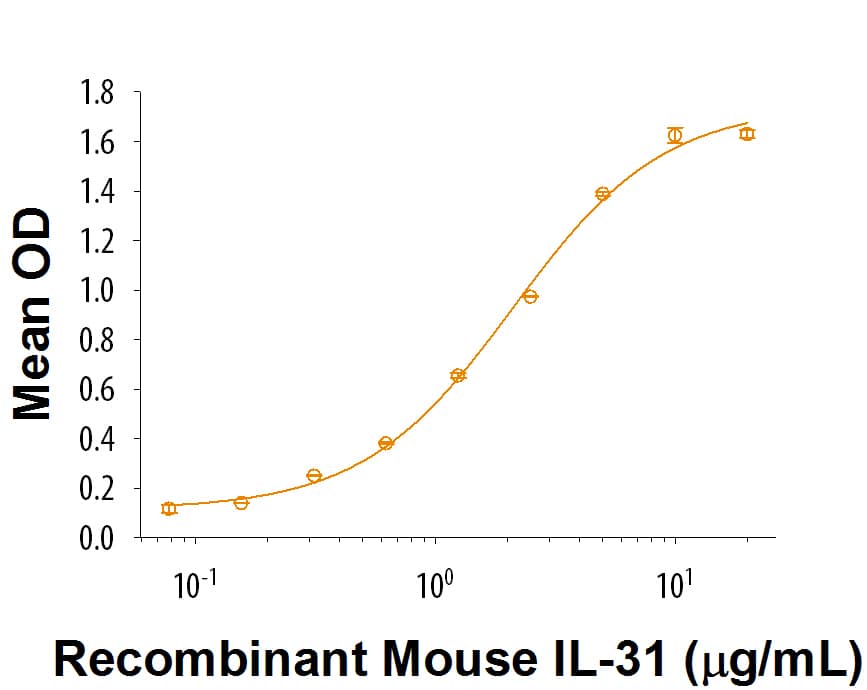Recombinant Mouse IL-31 Protein, CF
R&D Systems, part of Bio-Techne | Catalog # 3028-ML

Key Product Details
Product Specifications
Source
Thr24-Cys163
Purity
Endotoxin Level
N-terminal Sequence Analysis
Predicted Molecular Mass
SDS-PAGE
Activity
When Recombinant Mouse IL‑31 RA Fc Chimera (Catalog # 1253-IL) is immobilized at 5 µg/mL (100 µL/well), Recombinant Mouse IL‑31 binds with an ED50 of 0.9-5.4 μg/mL.
Reviewed Applications
Read 1 review rated 5 using 3028-ML in the following applications:
Scientific Data Images for Recombinant Mouse IL-31 Protein, CF
Recombinant Mouse IL-31 Protein Binding Activity
When Recombinant Mouse IL-31 RA Fc Chimera (1253-IL) is immobilized at 5 µg/mL, Recombinant Mouse IL-31 (Catalog # 3028-ML) binds with an ED50 of 0.9-5.4 µg/mL.Formulation, Preparation and Storage
3028-ML
| Formulation | Lyophilized from a 0.2 μm filtered solution in Acetic Acid and NaCl. |
| Reconstitution |
Reconstitute at 100 μg/mL in 10 mM Acetic Acid.
|
| Shipping | The product is shipped at ambient temperature. Upon receipt, store it immediately at the temperature recommended below. |
| Stability & Storage | Use a manual defrost freezer and avoid repeated freeze-thaw cycles.
|
Background: IL-31
Mouse Interleukin-31 (IL-31) is likely a secreted, 24‑33 kDa short-chain member of the alpha-helical IL-6 family of cytokines (1, 2). The mouse IL‑31 cDNA encodes a 163 amino acid (aa) precursor that contains a 23 aa signal peptide and a 140 aa mature protein (3, 4). The mature region shows four alpha‑helices which would be expected to generate a typical up-up-down-down topology. There are three potential sites for N‑linked glycosylation. Mature mouse IL-31 shares 29% and 63% aa sequence identity with human and rat IL-31, respectively. Neither mouse nor human IL-31 are active on their counterparts receptors (1). IL-31 is associated with activated T cells and is preferentially expressed by Th2 rather than Th1 cells (1). IL-31 signals via a heterodimeric receptor complex composed of a newly identified, 120 kDa, gp130-related molecule termed IL-31 RA (also GPL and GLM-R) and the 180 kDa oncostatin M receptor (OSM R beta) (4‑8). In the complex, IL‑31 directly binds to IL‑31 RA, not OSM R (4, 5). IL-31 signaling has been shown to involve the Jak/STAT pathway, the PI3 kinase/AKT cascade, and MAP kinase pathway. Although multiple isoforms of IL-31 RA are known, only a form that contains the entire length of the cytoplasmic domain is signaling-capable (4‑7). The IL-31 receptor is constitutively expressed by keratinocytes and upregulated by IFN-gamma on monocytes (1, 3). Other cells known to be responsive to IL-31 include bronchial epithelium, type II alveolar cells, goblet cells, and likely hematopoietic progenitor cells (9‑11). Functionally, it has been shown that IL-31 may contribute to clinical pruritis (itching) associated with nonatopic dermatitis (1, 3, 12). This may be a consequence of IL-31’s ability to induce keratinocyte secretion of multiple cytokines, including TARC, GRO‑ alpha, MIP‑3 beta and I-309 (1). In addition, IL-31 promotes proliferation of high density cell populations such as myeloid progenitor cells, but conversely suppresses proliferation of lung epithelial cells (1). Finally, IL-31 may actually have a modulating effect on T cell subsets, influencing the ratio between Th1 and Th2 cells (1).
References
- Zhang, Q. et al. (2008) Cytokine Growth Factor Rev. 19:347.
- Venereau, E. et al. (2009) J. Biol. Chem. 285:14955.
- Dillon SR, et al. (2004) Nat. Immunol. 5:752.
- Diveu C, et al. (2004) Eur. Cytokine Netw. 15:291.
- Dreuw A, et al. (2004) J. Biol. Chem. 279:36112.
- Dieu C, et al. (2003) J. Biol. Chem. 278:49850.
- Ghilardi N, et al. (2002) J. Biol. Chem 277:16831.
- Mosley, B. et al. (1996) J. Biol. Chem. 271:32635.
- Chattopadhyay, S. et al. (2007) J. Biol. Chem. 282:3014.
- Perrigoue, J.G. (2009) J. Immunol. 182:6088.
- Broxmeyer, H.E. et al. (2007) Exp. Hematol. 35 (Suppl 1):78.
- Takaoka, A. et al. (2005) Eur. J. Pharmacol. 516:180.
Long Name
Alternate Names
Gene Symbol
UniProt
Additional IL-31 Products
Product Documents for Recombinant Mouse IL-31 Protein, CF
Product Specific Notices for Recombinant Mouse IL-31 Protein, CF
For research use only
